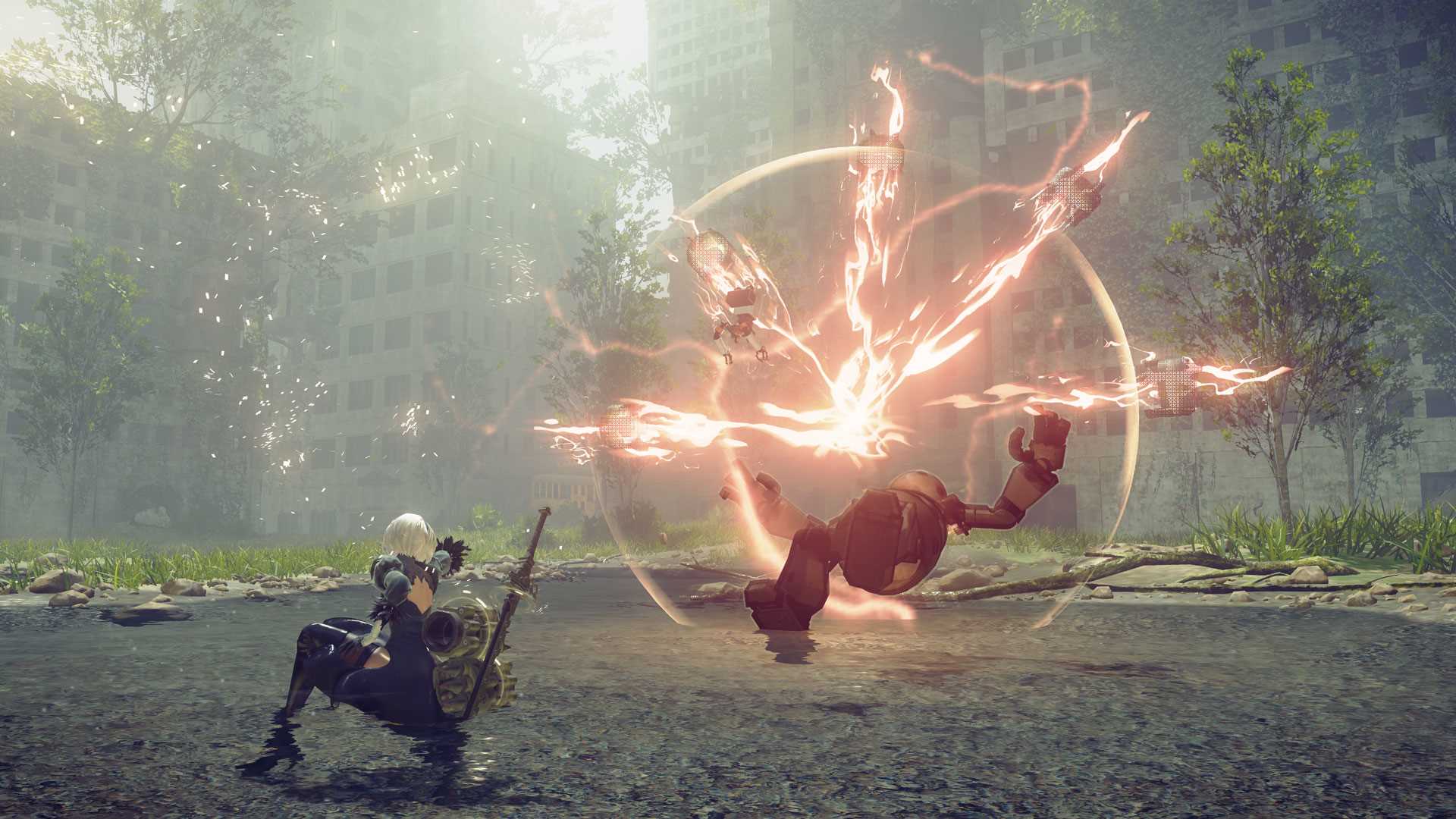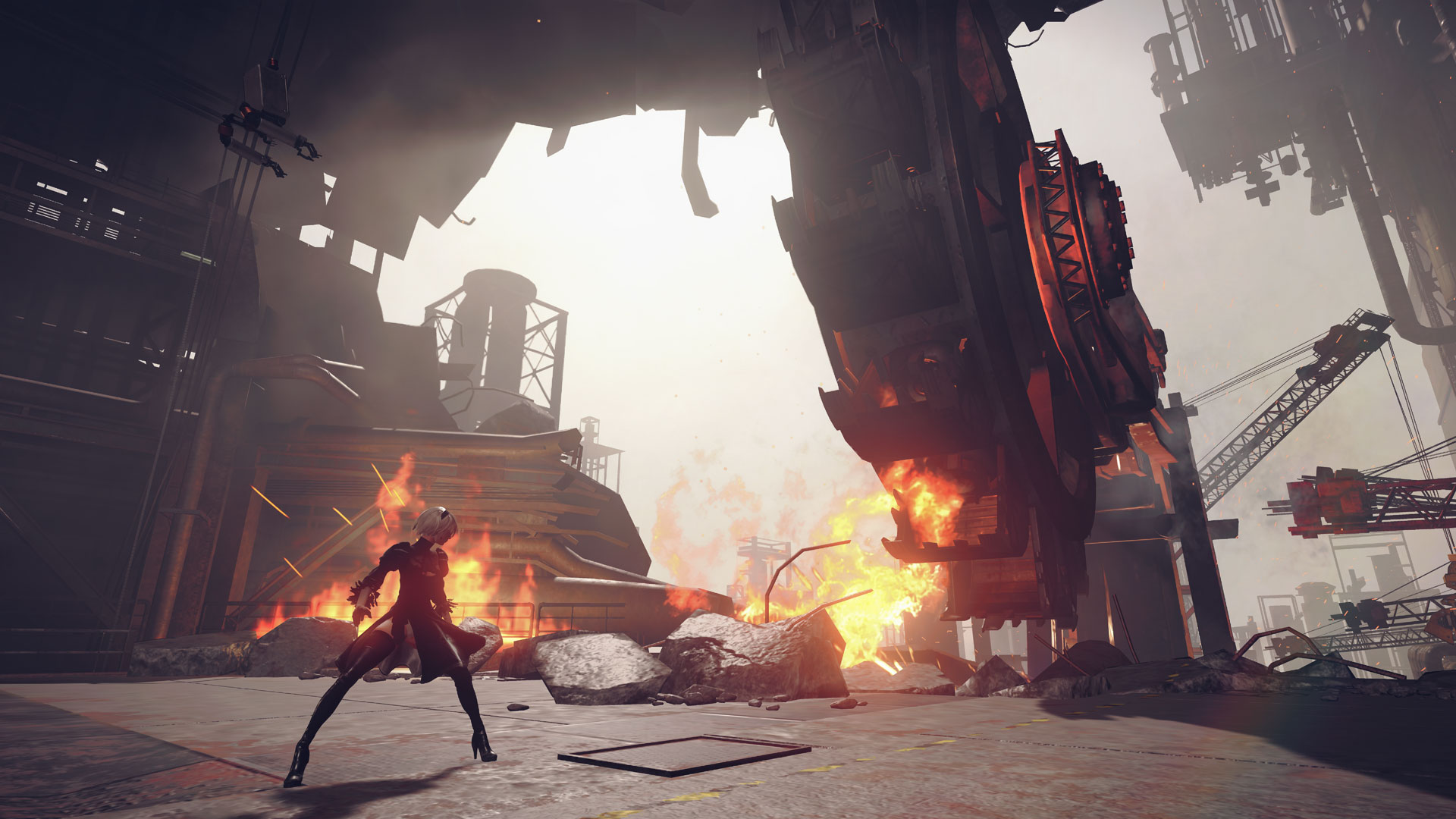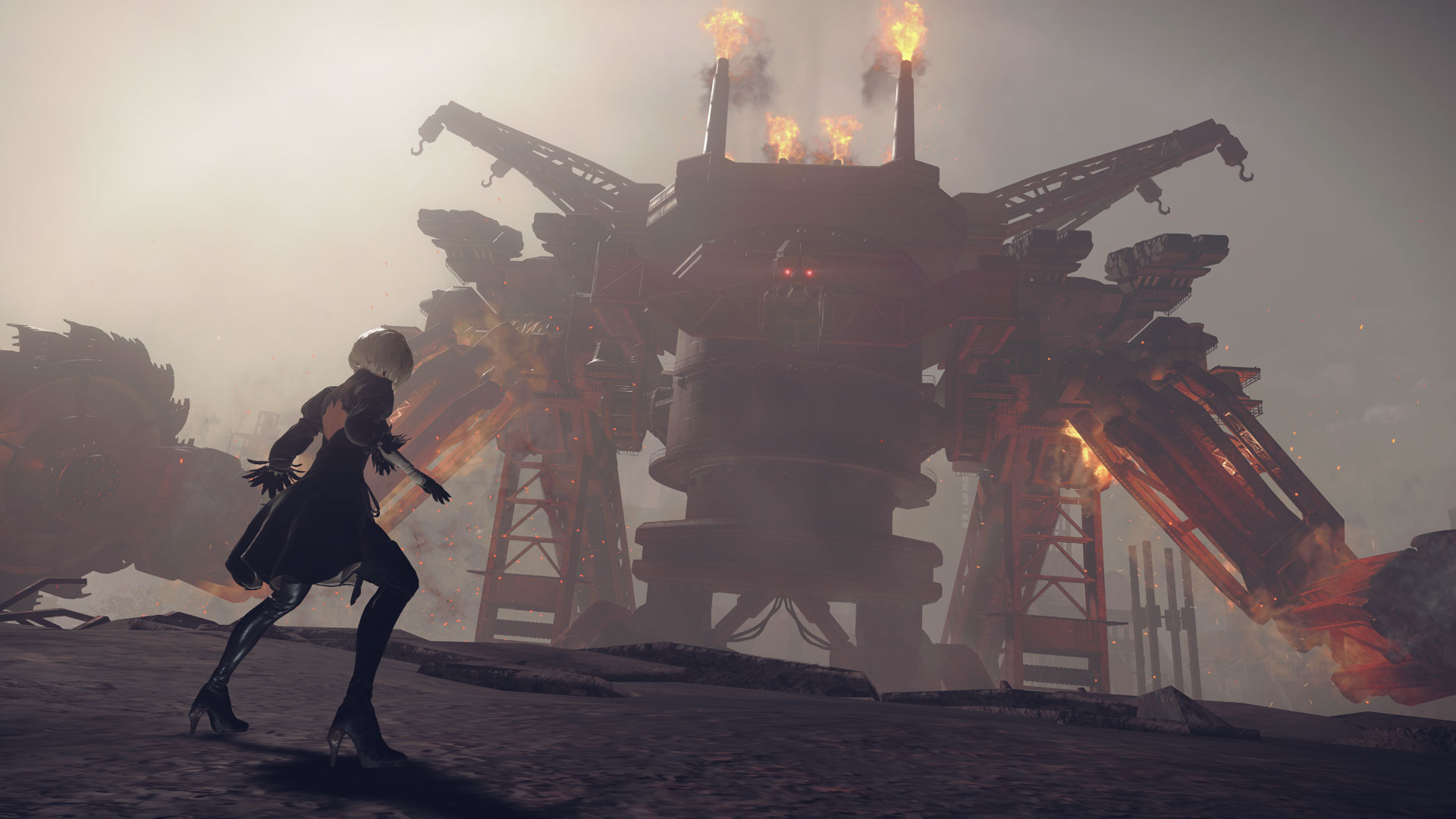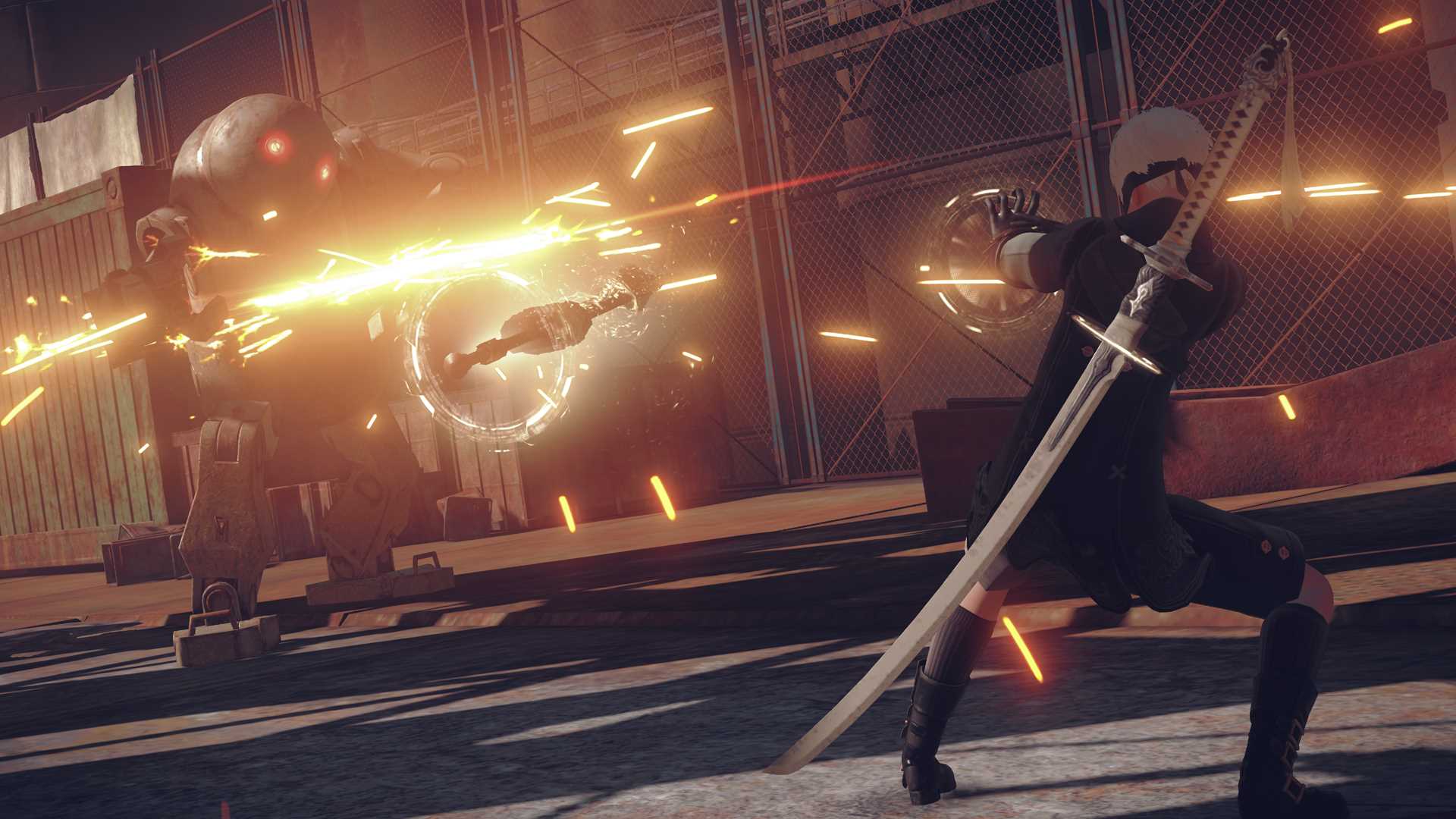NieR: Automata: An interview with Taro Yoko, Yosuke Saito and Takahisa Taura
It’s been almost seven years since the original NieR released onto home consoles. Seven years since Taro Yoko’s cultish vision garnered a wave of middling reviews and lacklustre sales figures but created an almost feral fan base who became so invested in the characters and universe. Cavia, the developer of the original title, was absorbed shortly after the game’s release, leaving the future of the series unknown.
The distilled passion and dedication of fans, however, gave birth to NieR: Automata, a direct sequel to NieR being developed by Platinum Games. Set in the same post-apocalyptic world with a new cast of characters, many of the creatives behind the original have found themselves involved in this follow-up in order to carry on their vision: Taro is back as game director, and Yosuke Saito has returned to his role as producer. Some new faces have entered the mix too, including Takahisa Taura, a game designer at Platinum Games, who aims to use his studio’s signature combat systems to turn NieR: Automata into an RPG masterpiece. I sat down and spoke to all three to discuss development and their aspirations for and beyond release.
“The core NieR design team is back, with of course Mr. Taro Yoko, who is the story writer and creator, and Mr. Okabe Keiji, the music composer being front and centre,” Saito tells me. “The original characters were designed by an artist called DK. Unfortunately for this game, he hurt his elbow so he can’t actually draw at the moment, so we couldn’t use him for this game.” Saito gestures, rubbing his elbow and frowning as our translator speaks these words, throwing him off. “However, one of the biggest things we’re very happy about for the development is the fact that we could get Mr. Yoshida Akihiko, a very famous character designer from Final Fantasy XII and Final Fantasy XIV, on board to design the characters for this game. So we negotiated with these people and got them on board which was really good.”

Integrating the vision of one studio into that of another is not something which happens often in game development, but Saito tells me he feels lucky to have ended up at Platinum Games to work on the sequel. “I think the biggest advantage, the biggest merit to development is the action parts of the game,” he says, gesturing to an almost blushing Taura. “I mean, Platinum Games is such an amazing action game developing studio, they’re one of the top studios in the world so that’s definitely a big plus for NieR: Automata having them on board.”
The passion exists at Platinum, too. Although the studio was in no way involved with development of the original NieR, many of the developers are die hard JRPG fans and were familiar with the title. “One of the other really great things is the fact that the team are very young at Platinum Games, lead by Mr. Taura here. There are lots of them that love NieR and are great fans of the game, so that worked out really well too.”
Taro, however, takes a more laid back approach. He too is glad to have found himself at Platinum Games, but jokes that all his work is done for him. “I mean, I was told by Mr. Saito here to go to work on the game in Osaka and work with these guys,” he says. “I was told that there was a really great, really talented development team there and it turns out it’s true, it’s great. All I have to do is sit there drinking beer all day and they make the game for me.”

Saito, astonished at this claim, chimes in and asks Taura: “Sorry, I want to ask you, was he really sat there drinking beer all day?”
“Yes!” Taro squeaks in a high-pitched voice, to much laughter around the room.
Taura shakes his head. “To be accurate about that, it wasn’t beer. He was just sat there drinking Coke all day,” he says, gesturing to Taro’s can of Diet coke sitting on the table in front of him. Taro averts his eyes and laughs.
Upon release in 2010, NieR was overlooked by the mainstream and is pretty hard to come by these days at a reasonable price. There will be plenty of people who have played the Automata demo or have been enamored by various trailers who’d like to jump in, but have never played or even heard of the original. This can be quite a modern problem, so I asked if NieR: Automata is accessible to new players as well as returning ones.

“Um… yes,” Taro says frankly. “I think there are a lot of games out there where the series has gone on and you can’t really enjoy them unless you’ve played the previous games, and I really don’t like that kind of game at all. I always try to make my games so that you can come in with a complete blank slate and enjoy them from the start with no previous knowledge. And then of course on top of that, I like to include some hidden references and things that will be interesting and enjoyable for players who played previous games in the series,” he continues. “But that’s very much separate from the main flow of the game, so completely new players, you should be able to enjoy it with no trouble at all.”
Reviews of the original NieR criticised a wide variety of things: dated graphics, unexceptional combat mechanics, and the repetitiveness of some side quests. The game, released in two versions in Japan and known as Gestalt on Xbox 360 and Replicant on PS3, under-performed in terms of sales. Gestalt shifted only 12,500 copies during its first week of release, mainly due to the limited popularity of Xbox consoles in the region. Replicant performed slightly better, selling 121,000 copies by the end of May 2010, but only managed to sell an extra 14,000 copies by the time the year ended. Fans expressed their dismay, and shared their feedback on the game with developers, which Taro says helped build a case for a sequel.
“About the fans of the previous game and the way it sold, it is the truth: it didn’t sell perhaps as well as it could have done,” he explains. “You are right, there were a lot of passionate, dedicated core fans who really supported the series. If you are asking if they gave us ideas we could use for this episode in the series, it’s not quite so much that. That feedback was important to Mr. Saito, who is very much the one who decides what new products we’re going to release. He bases it on how much support there is. Again, I’m so happy to see that these fans have kept going with this passion for NieR and that’s what really convinced us and convinced him to go ahead and do this new game.”

“In Japan, there’s this term that’s used called ikkitōsen (騎当千) which literally means one lone soldier going into battle and taking down a thousand enemies,” Taro continues. “And that’s exactly what the NieR fans are like: they support the game as much as a thousand individual fans. They are that passionate and it’s really great to see that level of dedication.”
With NieR underperforming in all regions, it is easy to assume that many would be apprehensive to continue a series that had not attracted a great amount of mainstream attention. I asked Taro if it was tough to get the others on board to return for Automata, but he told me this was not the case at all, it’s more about what he’s not told to do, as opposed to what he is, that allows him to be creatively zany.
“No, my impression of the development team and what it was like there really didn’t include any of that at all,” Taro says, making reference to the eagerness of the new employees on board. “Everyone was just really excited and happy and joyful to be working on this project.”

“Generally, I just do what I’m told to really. So if Square Enix say you’re doing a NieR sequel, I say: “Oh yes okay, I’m doing a NieR sequel”. But when I’m not told, I’m quite free to experiment and try things out. For example, for the main character, no-one said you can’t give her a blindfold so I went and gave her a blindfold. Things like that! People come back afterwards and say ‘I don’t like that!’, and I say ‘Well you didn’t tell me not to do it!’ So if you give me a list of bullet points at the start, I’ll do exactly what you tell me. I’ll do anything you want.”
NieR: Automata will release in a single version worldwide, meaning all players will follow to story of reconnaissance android models 2B and 9S. This parity, Taro explains, was much requested from his fans outside of Japan who had yearned to play the two different versions of the original: the English version featured the characters as father and daughter, while the alternate Japanese versions featured them as father and daughter in Gesalt and brother and sister in Replicant. Also, Taro is never one to get stuck in his ways.
“The Square Enix company view and my own personal thoughts are actually quite different. My personal view, I remember at the time that there were a lot of articles, a lot of people who compared the PlayStation 3 with Xbox 360; the same versions of games and comparing frame rates and things like that. So I felt if we make it complete different from the start, people won’t be able to compare it because it won’t be the same thing.”

“I think Square Enix probably feels differently,” Taro goes on, “but the reason I didn’t do it this time is because I’ve already done two versions before. I’m bored of doing that now.”
Saito chimes in, saying it was a no-brainer in terms of fan satisfaction, frugality, and overall product quality: “It was a decision that was made right from the start on the development for this game,” he says. “Obviously if you split the two versions and make them different in some way, that takes a lot more effort and development cost so we thought rather than doing that, it would be a better idea, obviously with Platinum Games on board and with their help, to concentrate everything into one single version and make it the best version that we could.”
After Saito’s response, Taro discusses the main character of 2B and jokes about the various ideas thrown about during development. “Certainly the star of the show is a female character, we did have discussions about making her an old lady, an old granny,” he laughs. “I want to play a game where you’re playing as an old woman and she saying ‘Oh, my knees!’ Maybe next time,” he says, shrugging.

The demo, released on PlayStation 4 just before Christmas, received very high praise from critics and players alike. Many felt that Platinum’s combat added a whole new dimension to the series, making it feel more lively and enjoyable than ever. But with great power comes great responsibility, so I was curious to know whether the fanfare had the team feeling the pressure in the run up to worldwide release.
“No, I don’t really feel pressure myself and certainly a lot of people are saying great things about Platinum’s action,” says Saito. “I think that’s only right and is something that really should be valued because it really is that good. But in my own personal opinion, I think what makes NieR complete is that story by Mr. Taro. The reason we weren’t expecting that high praise for the demo is because it lacks that story element. We were a bit surprised it was received so well in some ways, but I want to see more praise of course, for Mr. Taro’s story.”
Taro, flattered, insists: “It is very interesting looking at the reactions and all this praise coming from the fans and people are speaking so highly of it. I mean my story is really, really poor–it’s a piece of shit, really. It’s worth nothing, adds zero points into the review but Platinum Games action is worth 120 points. Overall, that’s 120% rating, so I think it’s worth it!”

Taura, reluctant to let Taro play down his story’s involvement, reiterates Saito’s point, saying: “I’m really happy to see this reaction to the demo that we put out because it really does show all the work we’ve done on it at Platinum Games, and it’s great to hear people good stuff about what you’ve done. But again, as Mr. Saito said quite rightly, the main version of the game has all of that story and that narrative aspect from Mr. Yoko in there which really works as a catalyst for our action, takes it to even higher levels, and I think people are going to have a lot of fun. I really hope for people to buy the game and enjoy it a lot, and then hopefully, that will lead to discussion of further sequels in the series, so we shall see.”
As per usual with our interviews, we pose the question which divides mankind to this day; the question which will no doubt lead to an apocalyptic reality, not unlike the world of NieR, at some point in the future. Ketchup: in the fridge, or in the cupboard?
“Fridge!” all three chime in unison, looking at each other and laughing. Seeing the disgust on my face, Taro quickly explains: “I think most Japanese people will put things like ketchup and mayonnaise in the fridge, we don’t really have a custom of having them outside.”

I shake my head and tut, laughing as our translator communicates my displeasure. “At least my editor will be happy,” I say.
“Yes, yes, we are with your editor!” says Taro.
I hope you’re happy, Adam.
NieR: Automata is released for PlayStation 4 and PC on February 23 in Japan, March 7 in North America and March 10 in Europe.





